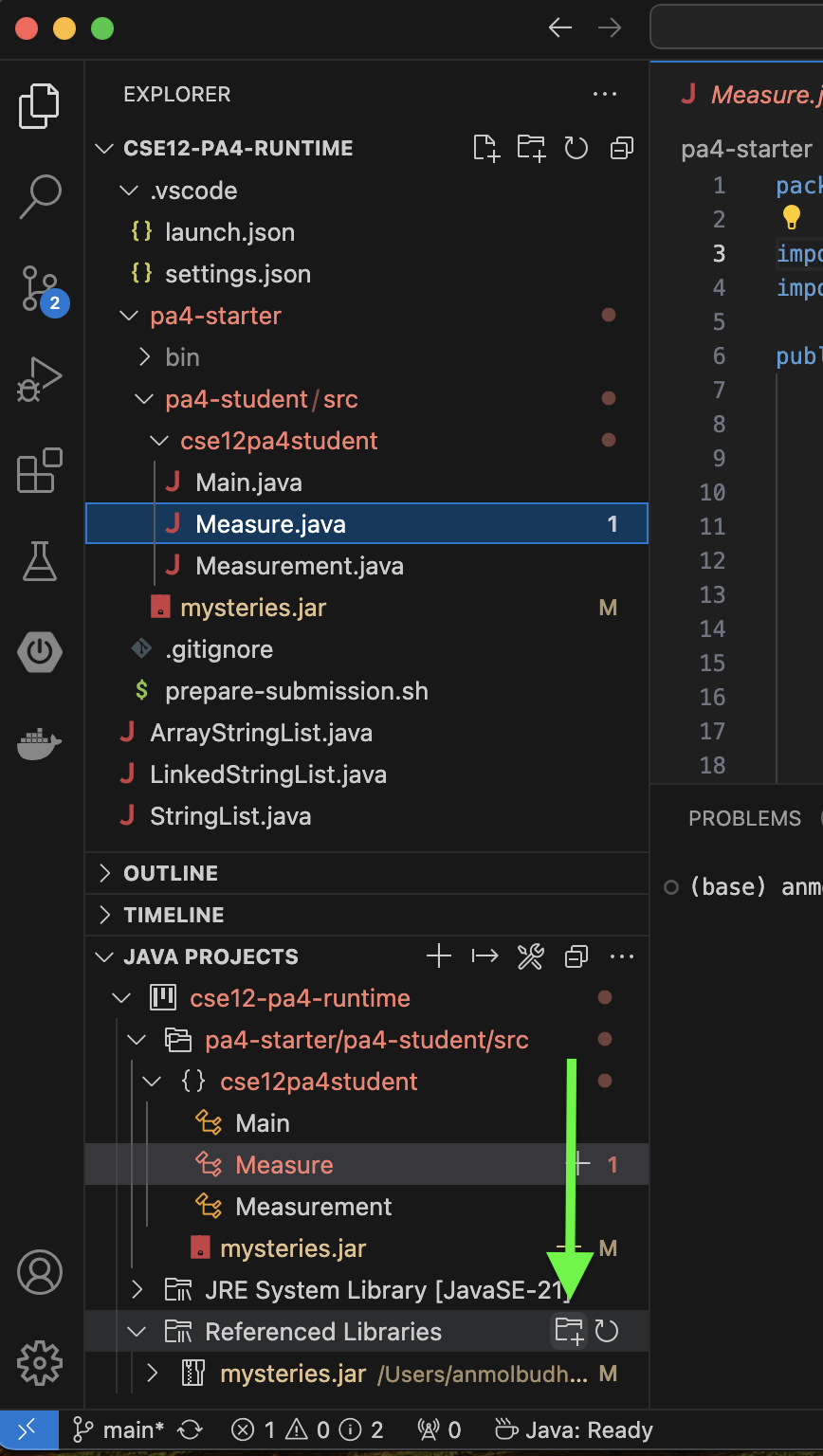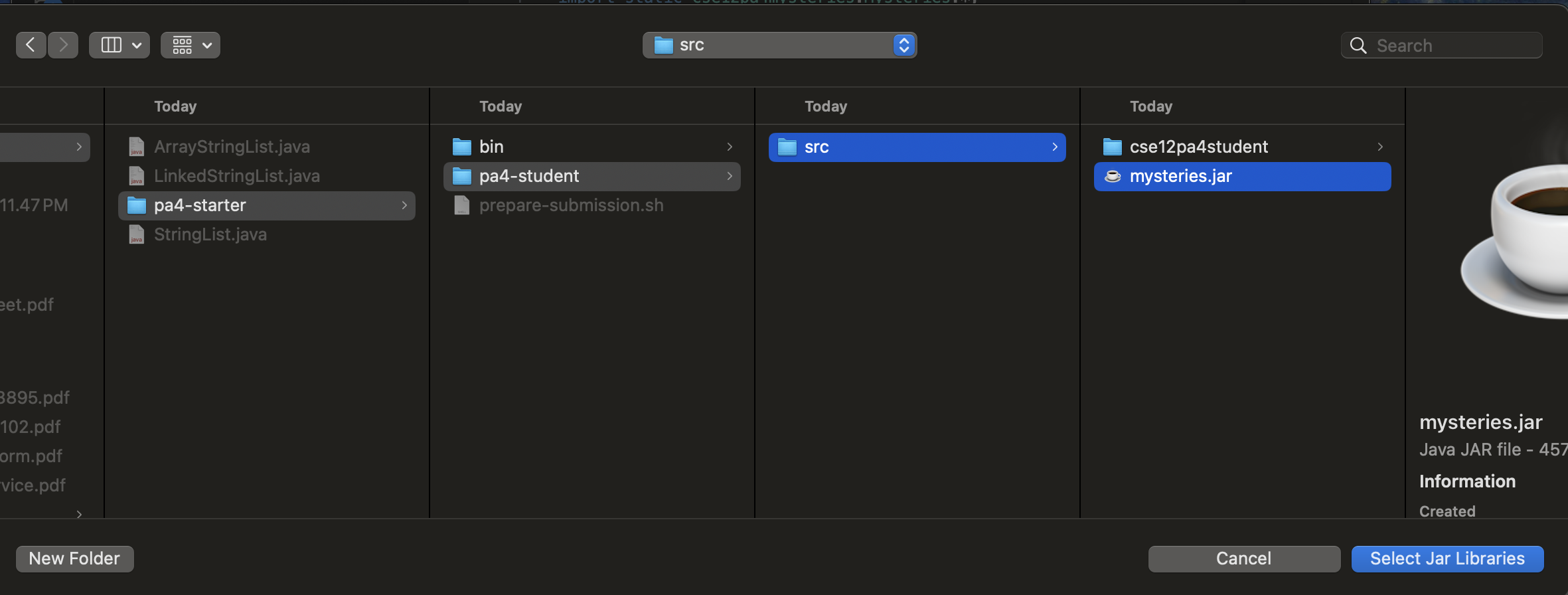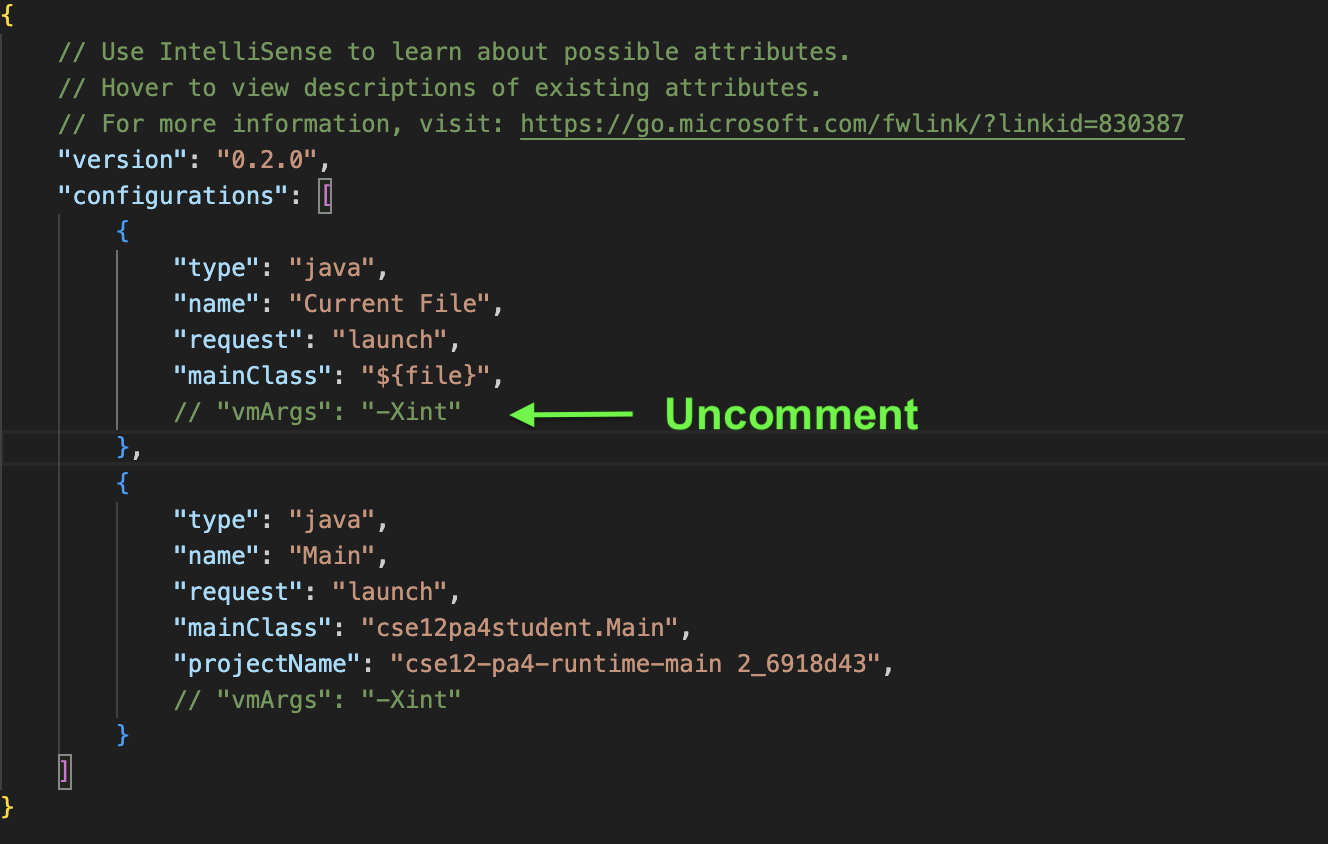CSE 12 Programming Assignment 4
Runtime, Measured and Modeled
This assignment is open to collaboration.
This assignment will give you experience working with big-Ο/θ/Ω representations, practice matching them to implementations, and perform measurements of the runtime of different methods.
This assignment is inspired by a combination of a lab in Swarthmore College’s CS35, and by a similar assignment by Marina Langlois in CSE12 at UCSD
This PA is due on ** Wednesday, May 1 at 8:00am **
Getting the Code
The starter code is at here. If you are not familiar with Github, here are two easy ways to get your code.
-
Download as a ZIP folder
If you scroll to the top of Github repository, you should see a green button that says Code. Click on that button. Then click on Download ZIP. This should download all the files as a ZIP folder. You can then unzip/extract the zip bundle and move it to wherever you would like to work. The code that you will be changing is in the folder called pa4-starter.
-
Using git clone (requires terminal/command line)
If you scroll to the top of the Github repository, you should see a green button that says Code. Click on that button. You should see something that says Clone with HTTPS. Copy the link that is in that section. In terminal/command line, navigate to whatever folder/directory you would like to work. Type the command
git clone _where the_is replaced with the link you copied. This should clone the repository on your computer and you can then edit the files on whatever IDE you see fit.
If you are unsure or have questions about how to get the starter code, feel free to make a Piazza post or ask a tutor for help.
Part 1: Runtime Analysis Questions
Big-O Justification
Indicate whether the following assertions are true or false, and give a justification:
- (n*log(n) + 2n)/3n2 is Ω(1/n)
- (n*log(n) + 2n)/3n2 is O(1/n)
- log(log(n)) is Ω(1/n10)
- (2n)2 + n/4 + 6 is O((2n)!)
- 1/(n50) + log16 is Ω(1)
- n!-n1000 is _O(2n +1)_
If you are justifying the positive direction, give choices of n0 and C. For
big-Θ, make sure to justify both big-O and big-Ω, or big-O in both directions.
If you are justifying the negative direction, indicate which term(s) can’t work because one is guaranteed to grow faster or slower than the other.
As a quick guide, here is an ordering of functions from slowest-growing (indeed, the first two shrink as n increases) to fastest-growing that you might find helpful:
- f(n) = 1/(n2)
- f(n) = 1/n
- f(n) = 1
- f(n) = log(n)
- f(n) = sqrt(n)
- f(n) = n
- f(n) = n2
- f(n) = n3
- f(n) = n4
- … and so on for constant polynomials …
- f(n) = 2n
- f(n) = n!
- f(n) = nn
This portion will be submitted via Gradescope. It can be found in the Programming Assignment 4 - questions assignment (this is question 1).
List Analysis
Consider the two files ArrayStringList.java and
LinkedStringList.java, which are included in this repository.
Answer the following questions, and justify them with one or two sentences
each:
- Give a tight big-O bound for the running time of
insertin ArrayStringList - Give a tight big-O bound for the running time of
insertin LinkedStringList - Give a tight big-O bound for the running time of
removein ArrayStringList - Give a tight big-O bound for the running time of
removein LinkedStringList - Give a tight big-O bound for the best case running time of
addin ArrayStringList - Give a tight big-O bound for the worst case running time of
addin ArrayStringList - Give a tight big-O bound for the best case running time of
addin LinkedStringList - Give a tight big-O bound for the worst case running time of
addin LinkedStringList
In all cases, give answers in terms of the current size of the list, and assume that the list has some non-empty size n. That is, you shouldn’t consider the empty list as a best case; instead think about the best case based on other factors like size, capacity, and nodes.
Notable points to consider:
- Creating an array takes time proportional to the length of the array
- When considering the running time of a method, make sure to take into account any helpers methods it uses!
Example for get in the LinkedStringList class:
The get method is O(1) in the best case, when the index is 0. In this case
it will do constant work checking the index and immediately return the
first element, never entering the while loop.
The get method is O(n) in the worst case, because the index could be at
the end of the list (for example, index n - 1). In this case, the while
loop will run n times, spending constant time on each iteration, resulting
in overall O(n) number of steps taken.
This portion will be submitted via Gradescope. It can be found in the Programming Assignment 4 - questions assignment (this is question 2). Make sure to following the formatting instuctions!
Mystery Functions
We have provided you with a .jar file that contains implementations of the
following methods:
public static void f1(int n) {
int a = 0;
int i = 0;
while (i < n) {
a = i;
i++;
}
}
public static void f2(int n) {
int a = 0;
for(int i = 0; i < n; i += 3) {
a = i;
}
}
public static void f3(int n) {
int a = 0;
int i = 0;
while (i < n) {
for (int j = n; n > 0; n = n/10) {
a = i + j;
}
i++;
}
}
public static void f4(int n) {
int a = 0;
for(int i = 0; i < n; i += 1) {
for(int j = i; j < n; j += 1) {
a = i + j;
}
}
}
public static void f5(int n) {
int a = 0;
for(int i = 0; i < n * n; i += 1) {
for(int j = 0; j <= n; j += 1) {
a = i + j;
}
}
}
public static void f6(int n) {
int k = 1, a = 0;
for(int i = 0; i < n; i += 1) {
for(int j = 0; j <= k * 2; j += 1) {
a = i + j;
}
k = k * 2;
}
}
However, in that file, they are called mysteryA-F, and they are in a
different order, and we don’t provide the source of that file. You have two
tasks: determining a big-O bound for each method labeled 1-6 analyzing
the source above, and determining which mystery method A-F corresponds to the
implementations above by measuring against provided (but hidden)
implementation.
Identifying Bounds from Code
Determine a big-O bound for each function, and justify it with a few sentences. Give only the most relevant term, so use, for example O(n), not O(4n + 2). You will be submitting this via Gradescope. It can be found in the Programming Assignment 4 - questions assignment (this is also part of question 3). Make sure to following the formatting instuctions!
Part 2: Measuring Implementations
NOTE: For the Following Code, Make sure that you are running it from the root directory, that is cse12-pa4-runtime needs to be open in VSCode (The .vscode folder HAS to be in the root directory). If you open a subfolder, then your code won’t execute.
If it shows an error The import cse12pa4mysteries cannot be resolved, then follow these steps:
- Click on Referenced Libraries under the Java Projects Section in the Explorer, and then the + button on the right hand side as shown:

- Select the mysteries.jar file in the starter code under the src folder.

- Add the Jar File
- It should not be complaining now about the error!
You will write a program to:
- Measure the mystery methods
- Use your measurements to match the mystery methods to the sources above
- Generate several graphs to justify your work
You have a lot of freedom in how you do this; the deliverables you need to produce are specified at the end of this section. There are a few methods that we require that you write in order to do this, and they will help guide you through the measurement process.
The measure Method
You must write the following two methods in the Measure class:
public static List<Measurement> measure(String[] toRun, int startN, int stopN)`
public static String measurementsToCSV(List<Measurement> measurements)
where Measurement is defined in Measurement.java.
-
measureshould work as follows:-
It assumes each string in
toRunis one of the letters A-F. -
For each of the implementations to run, it runs the corresponding
mysteryXmethodstopN - startNtimes, providing a value ofnstarting atstartNand ending atstopNeach time. -
For each of these runs, it measures the time it takes to run. You can do this by using the method
System.nanoTime()(see here for its official Java documentation) -
For each of the measured runs, it creates a
MeasurementwhosevalueOfNfield is the value that was used for the given run, whosenamefield is the single-letter string of the implementation that ran, and whosenanosecondsToRunfield is a measurement, and adds it to a running list of measurements. -
The final result is the list of measurements.
-
Example:
This call:
measure(new String[]{"A", "B"}, 40, 100);
Should produce a list that has 122 measurements, 61 of which will have name
equal to "A" and 61 of which will have name equal to "B". Each of the 61
for each name will have a different valueOfN from 40 to 100, and each will
have a different number of nanoseconds (as was measured).
The measurementsToCSV method
The measurementsToCSV method takes a list of measurements (for example, as
returned from measure) and generates a comma-separated-values String of the
measurements. It should have the following format, where the first row is a
literal header row and the other rows are example data. Note that this data is
completely made up, and may not match your measurements.
You might choose to put all of the measurements for a single letter together:
name,n,nanoseconds
A,40,1034
A,41,1039
A,42,2033
... many rows for A ...
A,100,432
B,40,1034
B,41,4038
... many rows for B ...
You might also choose to put all of the measurements for a single round of n
together:
name,n,nanoseconds
A,40,1034
B,40,1034
A,41,1039
B,41,4038
A,42,2033
B,42,4038
... many alternating rows of A, B ...
A,100,432
B,100,8038
Either layout is fine, do what makes sense to you, or what matches your
measure function best, etc.
Strategies for Measuring
You can use the measure and measurementsToCSV methods to produce data about
how the functions behaved in terms of their runtime. You should fill in the
main method with whatever you find useful for using your measuring methods to
compare the mystery implementations. You have total choice in how you implement
this – you can add new helpers, print the CSV format out to a file, copy/paste
it into a spreadsheet, use a tool you like for plotting, etc. The goal is to
use measurements to identify the different implementations. Feel free to look
up documentation for writing Strings out to files and use it, or use
System.out.println and copy/paste the output, etc. It’s probably pretty
expedient to copy the data into Excel or a Google Sheet.
There are a few high-level strategies to consider:
- If an implementation is very slow, it could take a really long time to measure it for large n. If you notice something is taking a long time, stop the program and try the same mystery methods on a smaller input range. Does the smaller range tell you anything useful?
- Some of the methods might have similar big-O bounds, but have different constants that can be measured in terms of absolute time.
- Some of the methods might take vastly different times to run on certain inputs, so plotting them next to one another will show one with a flat line at 0 and the other with some interesting curve. Make sure to check what the relative numbers are when inspecting the output.
You will use these measurements to figure out which mystery method matches the implementations above, and generate three graphs to justify your answers.
Avoiding Obscuring Optimizations
On many platforms and Java versions, simple methods like the above get optimized to run much faster than their theoretical number of steps might suggest. Java is pretty smart – it can, while running, figure out how to make them run quickly enough that empirical measurements become hard to make. If you’re seeing that even on values of n in the hundreds of thousands, you get effectively constant behavior, you should try disabling these optimizations to get more useful measurements for distinguishing the implementations.
To turn off optimization in terminal:
- In your directory, navigate to .vscode/launch.json.
- There is an commented line starting with vmArgs. Just uncomment this and run your Main.java again, and optimization will be turned off.
- Make sure you are running through the Play Button in VSCode for this change to take place.
Note that this will make all the mystery methods run a lot slower, so you may want to decrease the values of n you use after making this change to avoid waiting a long time.

Submitting
Part 1
You may submit as many times as you like till the deadline.
- The
Programming Assignment 4 - questionsassignment in Gradescope, where you will submit the written part of this PA.- The first question your big-O justifications.
- The second question is for your List analysis.
- The third question is for your matchings for the mystery functions, along with your graphs and justifications. The following are what need to be answered in the subquestions.
- The BigO bounds for each implementation f1-6.
- A listing that matches each of mysteryA-F to an implementation f1-6 above
- Three graphs that justify a few choices above. These don’t need to
exhaustively describe all of your matchings, but they must be generated
from real data that you measured using
measure, and they must show an interesting relationship that helps justify the matching.
- The last section gives you a space to indicate who you collaborated with (if you collaborated with anyone).
If you want a guide on how to get from the CSV data to a graph, look here:
https://docs.google.com/document/d/1efFyv4QmggBMxrphb5gF40i5_wBUfIeUMw9-Abrs0fY/edit?usp=sharing
Part 2
The Programming Assignment 4 - code assignment in Gradescope is where you will submit your final code for performing measurements.
Please submit the following file structure:
- pa4-student
- src
- cse12pa4student
- Main.java
- Measure.java
- Measurement.java
- mysteries.jar
- cse12pa4student
- src
The easiest way to submit your files is to zip the pa4-student folder and upload that to Gradescope. Make sure you are including the folder pa4-student in your zip file!!! You may also use the bash script provided, prepare-submission.sh.
You may encounter errors if you submit extra files or directories. You may submit as many times as you like till the deadline.
Scoring (70 points total)
(70 total points)
- 16 points
measureandmeasurementsToCSV[autograded] - 12 points initial big-O justifications [manually graded]
- 16 points list method analysis [manually graded]
- 26 points matching activity [manually graded]
- 12 points for complexity bounds on f1-6
- 6 points for a correct matching
- 6 points for 3 relevant graphs
- 2 points describing how you measured
 Schedule
Schedule Calendar
Calendar Syllabus
Syllabus Questions
Questions Material
Material Assignments
Assignments Help Hours
Help Hours